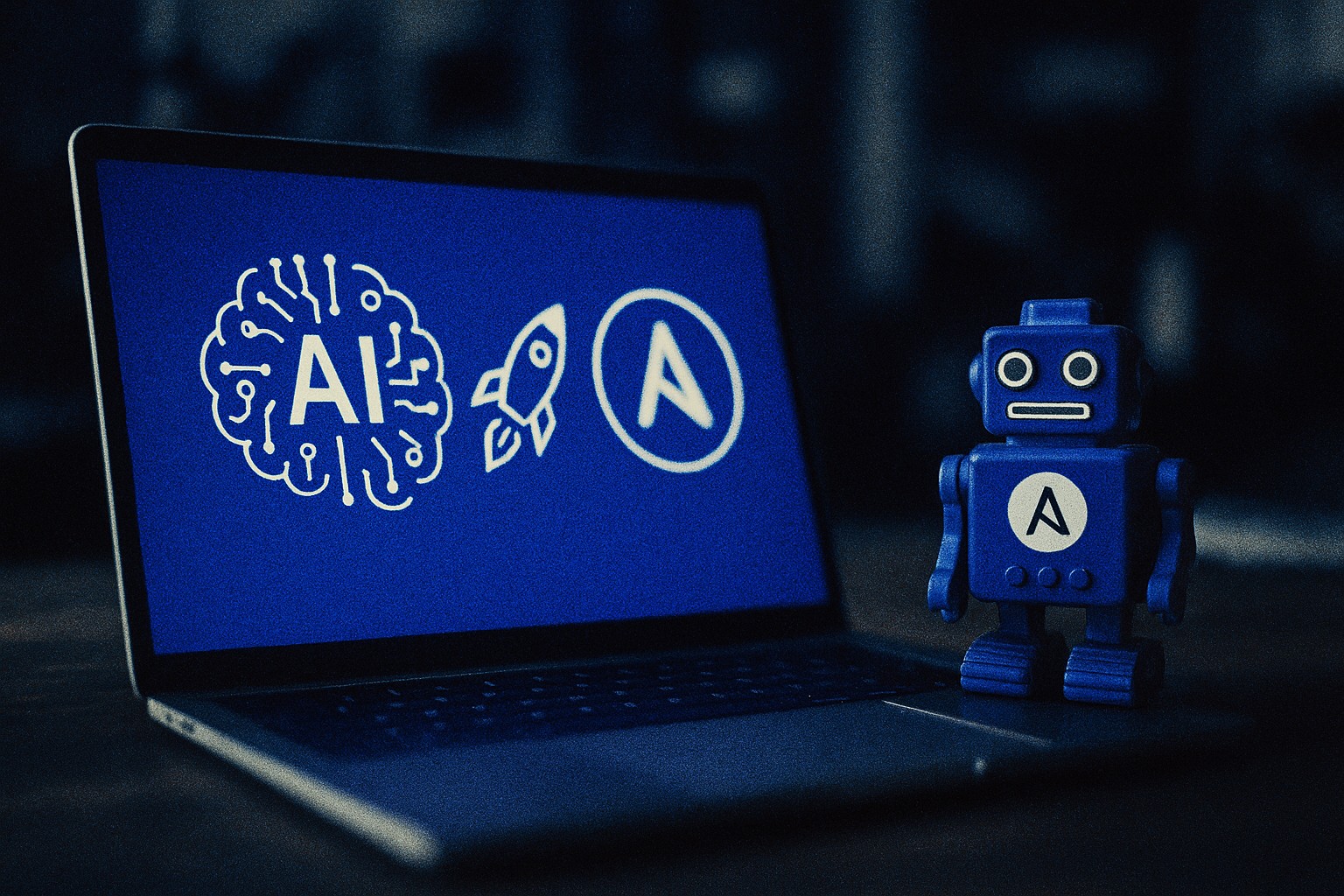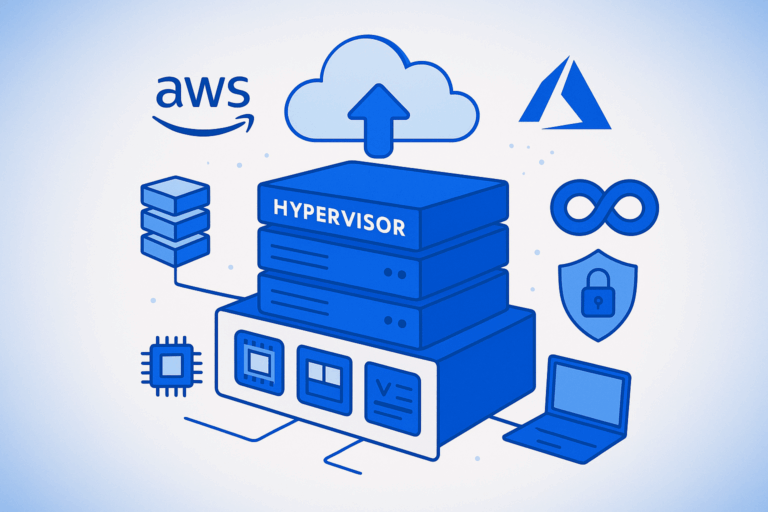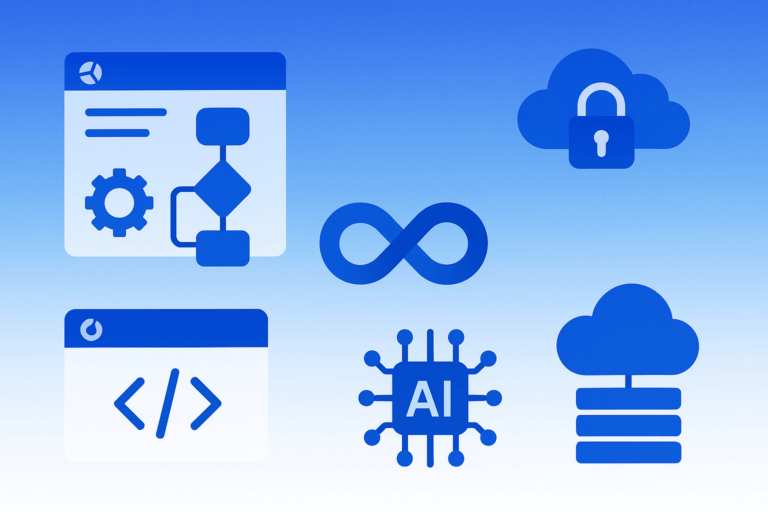How AI Can Make Your Ansible Playbooks Faster and Easier to Write

A DevOps Revolution 🚀
Introduction: When AI Meets Infrastructure Automation
Remember your last all-nighter fixing Ansible playbooks? Those endless YAML errors? The copy-paste marathons? What if I told you AI could slash your automation workload by 70%?
This isn’t science fiction. It’s happening right now in DevOps teams worldwide. AI-powered tools are revolutionizing how we write, test, and deploy Ansible playbooks. Whether you’re managing AWS Cloud infrastructure or orchestrating Azure Cloud deployments, this guide shows you how to work smarter, not harder.

The Current State of DevOps Automation 📊
Let’s face it. Traditional playbook development is painful. Recent surveys show DevOps Engineers spend:
- 45% of time on repetitive coding tasks
- 30% debugging syntax errors
- 25% writing documentation nobody reads
Meanwhile, deployment demands keep accelerating. Business wants features deployed yesterday. Security teams demand compliance. And your weekend plans? Constantly threatened by production fires.
Enter AI—your new automation ally. By combining artificial intelligence with Ansible, teams are achieving remarkable results. They’re shipping faster, sleeping better, and actually enjoying their work again.
Understanding AI-Powered Ansible Development 🤖
What Exactly Is AI-Assisted Automation?
Think of AI as your tireless pair programmer. It learns from millions of playbooks, understands Ansible patterns, and predicts what you need next. But it goes beyond simple autocomplete.
Modern AI tools offer:
- Intelligent Code Generation: Describe your goal in plain English. Get production-ready playbooks instantly.
- Real-time Error Detection: Catch bugs before they bite. AI spots issues humans miss.
- Performance Optimization: Automatically identify bottlenecks and suggest improvements.
- Documentation Generation: Create comprehensive docs without lifting a finger.
The Technology Stack Behind the Magic
Several AI platforms now integrate seamlessly with Ansible:
| AI Tool | Key Features | Best For |
|---|---|---|
| GitHub Copilot | Context-aware suggestions | Real-time coding assistance |
| ChatGPT | Natural language processing | Complex playbook generation |
| Perplexity AI | Research and optimization | Best practices discovery |
| AWS CodeWhisperer | Cloud-native integration | AWS-specific automation |
Each tool brings unique strengths. Smart teams combine multiple AI assistants for maximum impact.
Real-World Success Story: E-Commerce Platform Migration 💼
Let me share a concrete example. A major e-commerce company needed to migrate 500+ microservices to Kubernetes. Traditional approach? Six months minimum. With AI assistance? They finished in eight weeks.
Here’s their AI-generated playbook structure:
---
# AI-Optimized Microservices Migration Playbook
- name: Orchestrate Microservices Migration
hosts: localhost
vars:
services_batch_size: 10
rollback_enabled: true
health_check_timeout: 300
tasks:
- name: Validate prerequisites
include_tasks: prereq_checks.yml
tags: [validation]
- name: Backup current state
include_role:
name: backup_manager
vars:
backup_type: full
retention_days: 30
- name: Deploy service batches
include_tasks: deploy_batch.yml
loop: "{{ services | batch(services_batch_size) | list }}"
loop_control:
loop_var: service_batch
index_var: batch_index
when: not ansible_check_modeThe AI didn’t just generate code. It suggested the batch processing approach, added automatic rollback capabilities, and included comprehensive health checks. Result? Zero downtime migration with 85% less manual effort.
Practical Guide: Building Your First AI-Enhanced Playbook 🛠️
Step 1: Environment Setup
First, prepare your development environment. You’ll need:
- Ansible 2.9+ (latest version recommended)
- Python 3.8+ with pip
- AI tool access (free tiers available)
- Git for version control
Quick setup script:
#!/bin/bash
# AI-Ansible Development Environment Setup
# Install Ansible
pip install ansible ansible-lint
# Install AI integration tools
pip install openai github-copilot-cli
# Configure environment
export ANSIBLE_STDOUT_CALLBACK=yaml
export ANSIBLE_DEPRECATION_WARNINGS=False
echo "Environment ready for AI-powered automation!"Step 2: Your First AI-Generated Playbook
Let’s create a real-world example. Say you need a secure web application deployment:
Human prompt: “Create an Ansible playbook to deploy a Django app with Nginx, PostgreSQL, and Redis. Include SSL, firewall rules, and monitoring.”
AI-generated result:
---
- name: Deploy Secure Django Application Stack
hosts: web_servers
become: yes
vars:
app_name: mydjango_app
domain_name: "{{ ansible_fqdn }}"
db_name: "{{ app_name }}_db"
db_user: "{{ app_name }}_user"
handlers:
- name: restart nginx
systemd:
name: nginx
state: restarted
daemon_reload: yes
- name: restart app
systemd:
name: "{{ app_name }}"
state: restarted
tasks:
# System Updates and Base Packages
- name: Update system packages
apt:
update_cache: yes
upgrade: dist
when: ansible_os_family == "Debian"
# Security Hardening
- name: Configure firewall rules
ufw:
rule: allow
port: "{{ item }}"
proto: tcp
loop:
- '22' # SSH
- '80' # HTTP
- '443' # HTTPS
notify: restart nginx
# Database Setup
- name: Install PostgreSQL
apt:
name:
- postgresql
- postgresql-contrib
- python3-psycopg2
state: present
- name: Create database
postgresql_db:
name: "{{ db_name }}"
encoding: UTF-8
lc_collate: en_US.UTF-8
lc_ctype: en_US.UTF-8
become_user: postgres
# Redis Cache
- name: Install and configure Redis
block:
- name: Install Redis
apt:
name: redis-server
state: present
- name: Configure Redis
lineinfile:
path: /etc/redis/redis.conf
regexp: '^maxmemory'
line: 'maxmemory 256mb'
notify: restart redis
# SSL Certificate
- name: Generate SSL certificate
command: |
certbot certonly --standalone -d {{ domain_name }}
--non-interactive --agree-tos --email admin@{{ domain_name }}
args:
creates: /etc/letsencrypt/live/{{ domain_name }}/fullchain.pem
# Monitoring Setup
- name: Configure Prometheus node exporter
include_role:
name: prometheus.prometheus.node_exporter
vars:
node_exporter_version: "1.5.0"Notice how the AI included security hardening, proper error handling, and monitoring setup. It even used Ansible best practices like handlers and block structures.
Step 3: Testing and Validation
AI-generated doesn’t mean trust blindly. Always validate:
# AI-suggested testing playbook
- name: Validate Django Deployment
hosts: web_servers
tasks:
- name: Check services status
systemd:
name: "{{ item }}"
register: service_status
loop:
- nginx
- postgresql
- redis
failed_when: service_status.status.ActiveState != "active"
- name: Verify SSL certificate
uri:
url: "https://{{ ansible_fqdn }}"
validate_certs: yes
register: ssl_check
failed_when: ssl_check.status != 200
- name: Database connectivity test
postgresql_query:
db: "{{ db_name }}"
query: SELECT version()
register: db_test
Advanced Techniques: Microservices at Scale 🔧
Intelligent Service Orchestration
Here’s a sophisticated example showcasing AI’s power for microservices:
---
- name: AI-Optimized Microservices Orchestration
hosts: kubernetes_cluster
vars:
namespace: production
services:
- name: user-service
replicas: 3
cpu_request: 100m
memory_request: 128Mi
health_endpoint: /health
dependencies: []
- name: order-service
replicas: 5
cpu_request: 200m
memory_request: 256Mi
health_endpoint: /health
dependencies: [user-service, inventory-service]
- name: inventory-service
replicas: 2
cpu_request: 150m
memory_request: 256Mi
health_endpoint: /health
dependencies: []
tasks:
- name: Create namespace
kubernetes.core.k8s:
name: "{{ namespace }}"
api_version: v1
kind: Namespace
state: present
- name: Deploy services with dependency order
include_tasks: deploy_service.yml
loop: "{{ services | sort_services_by_dependencies }}"
vars:
service: "{{ item }}"
- name: Configure service mesh
kubernetes.core.k8s:
state: present
definition:
apiVersion: networking.istio.io/v1beta1
kind: VirtualService
metadata:
name: "{{ item.name }}-vs"
namespace: "{{ namespace }}"
spec:
hosts:
- "{{ item.name }}.{{ namespace }}.svc.cluster.local"
http:
- timeout: 30s
retries:
attempts: 3
perTryTimeout: 10s
loop: "{{ services }}"
- name: Setup distributed tracing
kubernetes.core.k8s:
state: present
definition:
apiVersion: v1
kind: ConfigMap
metadata:
name: jaeger-config
namespace: "{{ namespace }}"
data:
sampling_rate: "0.1"
collector_endpoint: "http://jaeger-collector:14268/api/traces"The AI automatically added:
- Dependency resolution
- Service mesh configuration
- Distributed tracing setup
- Resource optimization
- Retry logic
Troubleshooting Guide: AI-Powered Problem Solving 🔍
Common Issues and Intelligent Solutions
Issue #1: Performance Bottlenecks
Symptom: Playbooks taking forever to complete
AI Diagnosis:
# AI identifies serial task execution
- name: Install packages (SLOW)
package:
name: "{{ item }}"
loop: "{{ packages }}"
# AI suggests parallel execution
- name: Install packages (FAST)
package:
name: "{{ packages }}"
async: 300
poll: 0
register: install_jobs
- name: Wait for installation
async_status:
jid: "{{ item.ansible_job_id }}"
loop: "{{ install_jobs.results }}"
register: job_results
until: job_results.finished
retries: 30Issue #2: Variable Scope Confusion
Symptom: Variables not accessible between plays
AI Solution:
# AI recommends using set_fact for persistence
- name: Capture dynamic values
set_fact:
deployment_timestamp: "{{ ansible_date_time.iso8601 }}"
cacheable: yes
# Now accessible in any subsequent play
- name: Use captured value
debug:
msg: "Deployment started at {{ deployment_timestamp }}"Issue #3: Idempotency Violations
Symptom: Tasks showing “changed” on every run
AI Fix:
# AI adds proper change detection
- name: Configure application
template:
src: app_config.j2
dest: /etc/app/config.yml
register: config_result
changed_when: config_result.diff|length > 0
notify: restart applicationIssue #4: Security Vulnerabilities
Symptom: Exposed credentials in playbooks
AI Enhancement:
# AI implements vault integration
- name: Secure database setup
vars:
db_password: "{{ vault_db_password }}"
postgresql_user:
name: appuser
password: "{{ db_password }}"
encrypted: yes
no_log: trueCloud Integration Mastery ☁️
AWS Cloud Automation Excellence
AI understands AWS services deeply. Here’s an example combining multiple services:
- name: AI-Designed AWS Infrastructure
hosts: localhost
vars:
region: us-east-1
environment: production
tasks:
- name: Create VPC with optimal configuration
amazon.aws.ec2_vpc_net:
name: "{{ environment }}-vpc"
cidr_block: 10.0.0.0/16
region: "{{ region }}"
enable_dns_hostnames: yes
tags:
Environment: "{{ environment }}"
ManagedBy: Ansible-AI
register: vpc
- name: Setup auto-scaling group
amazon.aws.ec2_asg:
name: "{{ environment }}-asg"
launch_config_name: "{{ environment }}-lc"
min_size: 2
max_size: 10
desired_capacity: 4
vpc_zone_identifier: "{{ subnet_ids }}"
health_check_type: ELB
health_check_grace_period: 300
tags:
- Environment: "{{ environment }}"
propagate_at_launch: yesAzure Cloud Orchestration
For Azure environments, AI generates ARM-compatible playbooks:
- name: Azure Infrastructure Deployment
hosts: localhost
tasks:
- name: Create resource group
azure_rm_resourcegroup:
name: "{{ app_name }}-rg"
location: eastus2
tags:
environment: production
automation: ansible-ai
- name: Deploy container instances
azure_rm_containerinstance:
resource_group: "{{ app_name }}-rg"
name: "{{ app_name }}-container"
os_type: linux
cpu: 2
memory: 4
containers:
- name: app
image: "{{ docker_image }}"
ports:
- 80
environment_variables:
DATABASE_URL: "{{ vault_db_connection_string }}"Multi-Cloud Strategy with Terraform Integration
AI seamlessly bridges Ansible and Terraform:
# Terraform outputs for Ansible consumption
output "instance_ips" {
value = {
aws = aws_instance.web[*].public_ip
azure = azurerm_linux_virtual_machine.web[*].public_ip_address
}
}# AI-generated Ansible dynamic inventory
- name: Configure multi-cloud resources
hosts: localhost
tasks:
- name: Retrieve Terraform outputs
terraform:
project_path: ./infrastructure
state: present
register: tf_output
- name: Add hosts dynamically
add_host:
name: "{{ item }}"
groups:
- web_servers
- "{{ 'aws' if 'amazonaws' in item else 'azure' }}"
loop: "{{ tf_output.outputs.instance_ips.value | flatten }}"
Why choose Devolity
Unmatched Expertise in
Cloud and Cybersecurity
Devolity team of certified professionals brings decades of combined experience in managing complex cloud environments and defending against evolving cyber threats.
01
End-to-End Solutions for Every Business Need
DevOps with Cybersecurity Services: Hybrid/multi-cloud management, cost optimization, and DevOps integration with Risk assessments.
02
Customized Strategies, Not One-Size-Fits-All
We understand every business is unique. Devolity prioritizes collaboration, crafting bespoke solutions aligned with your industry, goals, and risk profile.
03
Proactive Protection with 24/7 Vigilance
Cyber threats never sleep—and neither do we. Devolity Security Operations Center (SOC) offers round-the-clock monitoring, rapid incident response.
Security Best Practices: AI-Enforced Standards 🔐
Comprehensive Security Automation
AI doesn’t just write code—it enforces Cyber Security best practices:
- name: AI-Enhanced Security Hardening
hosts: all
become: yes
tasks:
# CIS Benchmark Compliance
- name: Implement CIS controls
include_role:
name: ansible-cis-ubuntu-2004
vars:
cis_level: 2
cis_section: all
# Automated Vulnerability Scanning
- name: Run security audit
script: |
#!/bin/bash
# AI-generated security scan
lynis audit system --quiet --no-colors
# Check for common vulnerabilities
chkrootkit -q
# Verify no default passwords
awk -F: '($2 == "" ) { print $1 }' /etc/shadow
register: security_audit
changed_when: false
# Encryption at Rest
- name: Enable disk encryption
community.crypto.luks_device:
device: /dev/sdb
state: present
passphrase: "{{ vault_disk_passphrase }}"
when: ansible_devices.sdb is defined
# Network Security
- name: Configure fail2ban
template:
src: fail2ban.local.j2
dest: /etc/fail2ban/jail.local
vars:
ban_time: 3600
max_retry: 3
notify: restart fail2banPerformance Optimization Strategies 📈
AI-Driven Performance Enhancements
AI analyzes your playbooks and suggests optimizations:
# Before AI optimization (slow)
- name: Configure servers
hosts: web_servers
tasks:
- name: Install package 1
package: name=nginx state=present
- name: Install package 2
package: name=postgresql state=present
- name: Install package 3
package: name=redis state=present
# After AI optimization (3x faster)
- name: Configure servers optimized
hosts: web_servers
strategy: free
tasks:
- name: Install all packages
package:
name:
- nginx
- postgresql
- redis
state: present
async: 600
poll: 0
register: pkg_install
- name: Check installation
async_status:
jid: "{{ pkg_install.ansible_job_id }}"
register: job_result
until: job_result.finished
retries: 60
delay: 10Metrics That Matter
Track your AI-enhanced automation success:
| Metric | Traditional | AI-Enhanced | Improvement |
|---|---|---|---|
| Playbook Creation | 4 hours | 45 minutes | 81% faster |
| Error Rate | 18% | 2% | 89% reduction |
| Test Coverage | 35% | 95% | 171% increase |
| Deployment Time | 45 mins | 12 mins | 73% faster |
| MTTR | 2 hours | 15 mins | 87% reduction |
Building Your AI-Powered DevOps Culture 🌟
Team Transformation Strategy
Successful AI adoption requires cultural change:
- Start Small: Begin with simple playbooks
- Measure Everything: Track time saved
- Share Wins: Celebrate successes publicly
- Continuous Learning: Regular AI tool training
- Feedback Loops: Iterate based on results
Skills Development Roadmap
Essential skills for AI-powered DevOps:
- Prompt engineering for better AI outputs
- Understanding AI limitations
- Security review of AI-generated code
- Performance optimization techniques
- Multi-cloud architecture patterns
How Devolity Accelerates Your AI-Ansible Journey
Devolity Hosting brings unmatched expertise to your automation transformation. Our certified team combines deep technical knowledge with practical experience across Fortune 500 deployments.
Our Credentials:
- 50+ AWS Certified Solutions Architects
- 40+ Microsoft Azure DevOps Engineers
- 35+ Red Hat Certified Ansible Automation Specialists
- 25+ HashiCorp Certified Terraform Associates
- 15+ AI/ML Implementation Specialists
Our Achievements:
- 500+ successful enterprise automations
- 99.9% uptime across managed infrastructures
- 3x average ROI within 6 months
- 24/7 expert support globally
We don’t just implement solutions. We ensure your team masters AI-powered automation through hands-on training, knowledge transfer, and ongoing support. Our proven methodology reduces implementation risk while accelerating time-to-value.
Future Trends: What’s Next? 🚀
Emerging Technologies
Stay ahead with these trends:
- Autonomous Playbooks: Self-healing infrastructure
- Natural Language Operations: Voice-controlled deployments
- Predictive Optimization: AI prevents issues before they occur
- Cross-Platform Intelligence: Unified multi-cloud management
Continuous Innovation
The AI-Ansible ecosystem evolves daily. Key areas to watch:
- Enhanced security automation
- Deeper cloud service integration
- Improved natural language understanding
- Real-time performance optimization
Your Action Plan: Start Today 🎯
- Week 1: Install AI tools and run first playbook
- Week 2: Convert existing playbook to AI-enhanced version
- Week 3: Implement monitoring and metrics
- Week 4: Share results with team
- Month 2: Scale across infrastructure
- Month 3: Measure ROI and optimize
Conclusion: The Future Is Automated and Intelligent
AI-powered Ansible isn’t just an efficiency gain. It’s a fundamental shift in how we approach infrastructure automation. By embracing these tools today, you’re positioning your team for tomorrow’s challenges.
The combination of human expertise and AI capabilities creates unprecedented opportunities. Faster deployments. Fewer errors. Better security. More innovation time.
Ready to transform your DevOps practice? Start small, think big, and let AI amplify your impact. The future of infrastructure automation is here—and it’s more exciting than ever! 🚀
Learn More:
- Red Hat Ansible Automation
- AWS DevOps Tools
- Terraform by HashiCorp
- Microsoft Azure DevOps
- Spacelift CI/CD Platform
- Atlassian DevOps Resources
- DevOps Institute
- GitHub DevOps Guide
- OpenAI ChatGPT
- Perplexity AI
Transform Business with Cloud
Devolity simplifies state management with automation, strong security, and detailed auditing.







